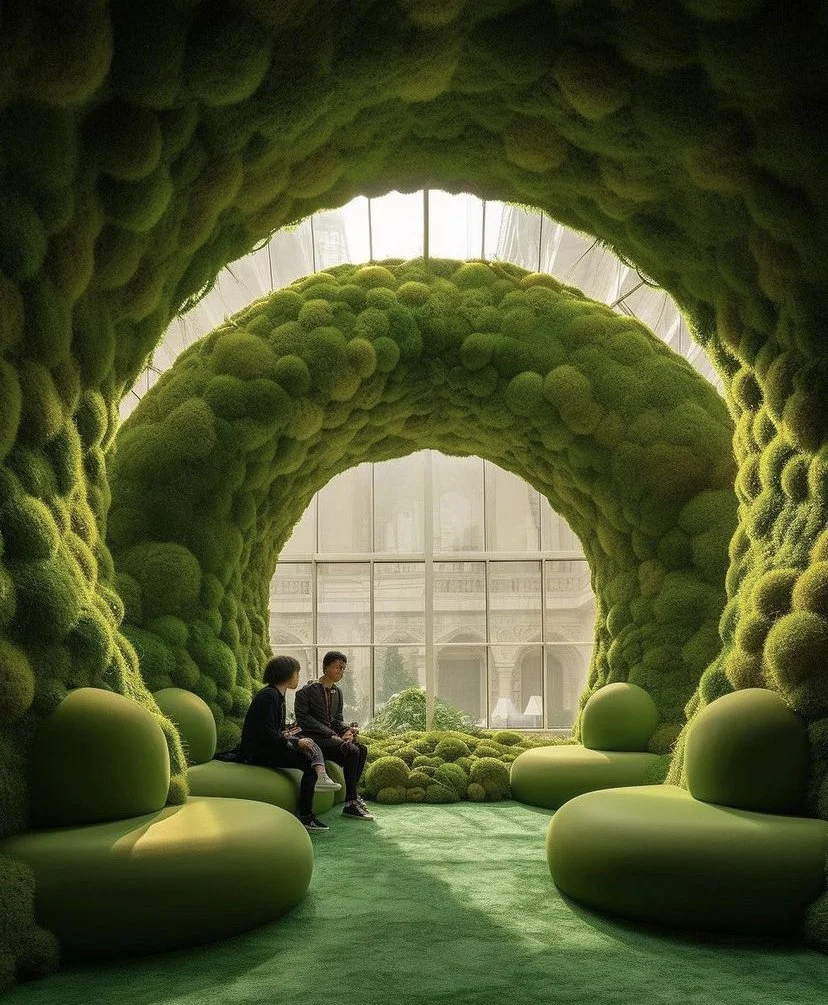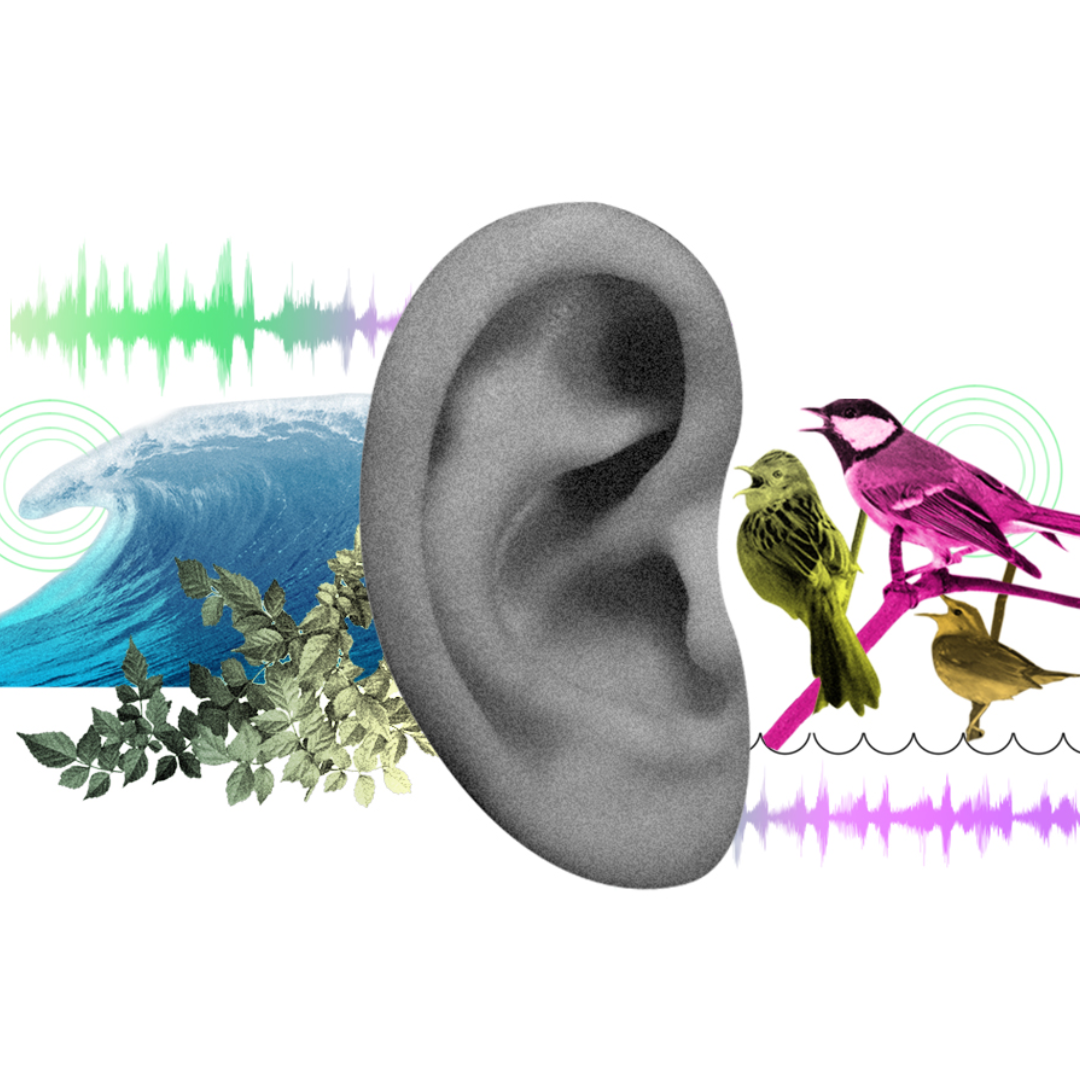The goal of this series is to explore the evidence-based brain benefits of nature’s multisensory cues in the built environment.
We invite you to delve into the strategic potential of using nature as a reference and tool to successfully mitigate noise pollution, lighting contamination and other sensory fields in the built environment. By the time you’re finished reading, you should have a strong foundation from which to draw inspiration, for building spaces that handle and redirect noise from a more humane perspective, to the benefit of all stakeholders.
We’ll accomplish this by analyzing case studies of well-executed experiences, places, and art installations that have studied the science of psychoacoustics, and applied their learnings towards constructions that turn noise away from danger – and towards delight.
Nature is multisensory, and many of its benefits are delivered and layered through the non-visual senses —a potential avenue through which architecture and design can influence wellness.
Nature Effect
Multisensory Nature: Going Beyond the Visual Layer in Biophilic Design
Today, Architecture and Interior Design professionals are investing in products and concepts that fully materialize wellness and multisensory integration. A stream that explores the endless ways of providing holistic sensory experiences to the users of a space, be it commercial, private or public area.
We gain multisensory experience from leaf-filled trees, the sounds of water and the fractals in what we see. Fresh smell of plants evoke chemical responses and stimulates our other senses. It turns out nature is multisensory… and so are we. Nature binds us together, holds us up, and brings us a fresh way of being at the center of our human experience.
The link between nature and human well-being is well established. Beyond physically looking at nature, evidence is emerging for other non-visual pathways for nature experiences to be effective. These include touching the textures of nature, listening to the sounds of nature, and even inhaling the scents found in nature.
Based on this, sensory design can evolve our approach to biophilic design and enhance the interaction between people and the built environment into something even deeper. After all, space is much more than just its appearance. Textures, sounds, and smells can strongly affect our perception.
The majority of the world’s population living in urban areas spend 95% of their time indoors.
Architecture exerts a profound influence over our well-being, given that the majority of the world’s population living in urban areas spend something like 95% of their time indoors. However, the majority of architecture is designed for the eye of the beholder, and tends to neglect the non-visual senses of hearing, smell, touch, and even taste. There has been little application of the growing understanding of the multisensory nature of the human mind that has emerged from the field of cognitive neuroscience research.
Our brain is biophilic by design.
Scientists are learning more about how and why we respond to natural stimuli in certain ways — research that can help designers to refine their application of biophilia to have greater impact. Biophilic design has emerged as a design approach that aims to reconnect occupants with the natural environment. While it is often viewed as a trend, we see this as a long term and evolving strategy.
Much of the research on the positive effects of nature and natural elements has examined their influence on mood. Factors such as access to daylight and views of nature, the presence of plants and water features, and even just images of nature or the use of patterns drawn from nature can elevate mood and encourage healing or enhance performance. Some recent studies reveal exposure to nature can benefit cognitive function as well.
Biophilic design is much more than adding potted plants to a space, it is a strategy for developing a multisensory relationship with the space around us. It is at the cross-section between the sustainability movement, wellness and human centered design. It’s also about the diversity of sounds, furniture, temperature, materials and spaces that can support occupants every need.
The effectiveness of biophilic design depends on interventions that are connected, complementary, and integrated within the overall environment rather than being isolated or transient.
Recent studies demonstrate that non-visual cues are equally as important for delivering benefits from nature experiences in the built environment.
Not every space can be designed to incorporate all the principles of biophilic design, but there are often many elements that can collectively enhance the interior and the well-being of those within it. Traditionally, architectural practice has been dominated by the eye/sight.
Research suggests that biophilia can have a positive impact on well-being by affecting three of our mind-body systems:
Physiological (eg. it reduces anxiety)
Psychological (eg. it reduces anger and fear)
Cognitive functions (eg. it improves creativity and boosts mood)
Sounds of Nature
Natural sounds, usually considered the most complex and informational of sound types, can provide information on species, season, and temporality, and it is likely that we are attuned to such cues. Indeed a component of attention restoration theory is that restorative environments provide us with information, and it thus seems plausible that the rich information content of nature sounds contributes to the restorativeness of natural landscapes.
Researchers at Brighton and Sussex Medical School in England explored the healing properties of nature, and its connection to our brain and body, in a study published in Nature. Seventeen adult participants listened to a series of five-minute sound clips of both natural and man-made environments. As each clip was played, the scientists scanned the participants' brain activity using fMRI machines. The scans showed that the natural sound clips physically affected what's known as the Default Mode Network in all of the participants' brains. This region is responsible for a “task-free” state of wakefulness that promotes relaxation. In other words, nature’s sounds diminished their body’s natural fight-or-flight instincts, which then prompted feelings of restoration.
A study published in the Proceedings of the National Academy of Sciences last year explored how spending time listening to natural sounds, particularly within national parks, may do the trick. The researchers analyzed sound recordings from 251 sites in 66 national parks across the U.S. The results showed that people who listened to the sounds of nature experienced improved mood, lower stress and better cognitive performance. Water was found to be the most effective at evoking positive emotions, while bird noises were the most successful in reducing stress.
Scent of Nature
Smells are everywhere, and this is true of both urban and natural environments. The main difference between these two environments is the abundance of anthropogenic smells in urban environments, and the lack of them in natural environments. Nature abounds in smells from flowers, trees, shrubs, grasses, animals, rotting matter, and insects. How these smells affect our health and well-being is an interesting, but relatively poorly studied question.
Our preferences for odors seem to be associated with the value we place on the objects associated with that odor, so smells that remind us of the outdoors can trigger any of the positive feelings we have about nature. Nature smells can thus function as a kind of trigger or symbol for nature in general and might deliver nature benefits by proxy. So while nature smells can have direct nature benefits, they can also have indirect nature benefits.
It makes sense that essential oils would have biological effects, as they are produced by plants to protect against herbivores and pathogens and to attract pollinators, however, evidence seems to be predominantly anecdotal thus far. Further experiments on clinical benefits are needed, and the controlled nature of studies thus far precludes understanding of whether such benefits can be experienced in everyday life. Nonetheless, the findings indicate an avenue for future research which could make unique contributions to the literature.
Textures of Nature
Touch is the first sense to develop in utero, and it can affect people’s willingness to comply with requests, create bonds between people and groups, strengthen romantic relationships, and reduce stress as measured by blood pressure and heart rate.
This involves taking a “hands on” approach to nature, such as that practiced in forest schools, where children are encouraged to play and learn outdoors; this is believed to be one mechanism through which nature benefits can be delivered. Children at these forest schools are believed to benefit from direct experience with nature in “confidence, social skills, language and communication, motivation and concentration, physical skills, and knowledge and understanding”, and motor skills have been found to improve more from play in the forest than in playground areas.
Forging a new relationship with nature, ourselves and one another.
The relationship between people and the rest of nature, is grounded in scientific study, and is measurable and accepted internationally. It involves understanding that we are part of nature. It is about our emotional connections and responses to nature, which help to regulate our own feelings and keep us mentally healthy. And it is about a meaningful relationship with the rest of nature rather than seeing it as something other. In short, it’s understanding that as humans nature is our multisensory story.
Looking to the future, the hope is that architectural design practice will increasingly incorporate our growing understanding of the human senses, and how they influence one another. Such a multisensory approach will hopefully lead to the development of buildings and urban spaces that do a better job of promoting our social, cognitive, and emotional development, rather than hindering it, as has too often been the case previously.
To build that new relationship, and hence the well-being of people and the rest of the natural world, we need to evolve our design approach and practices so that they enable people to connect with all the sensory layers of nature.

